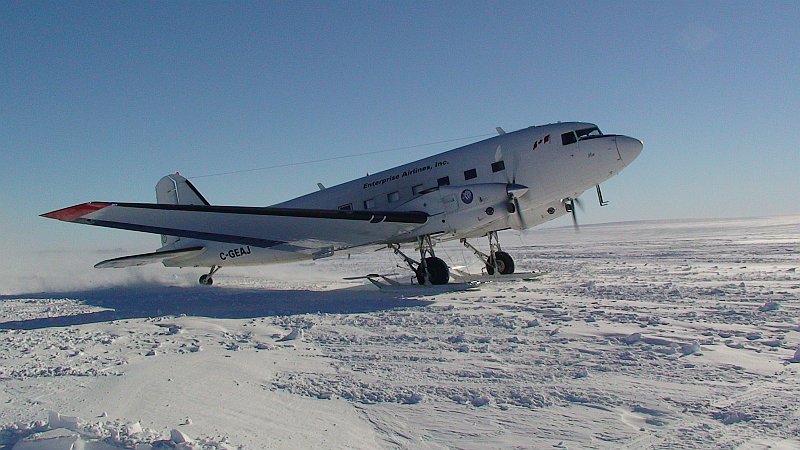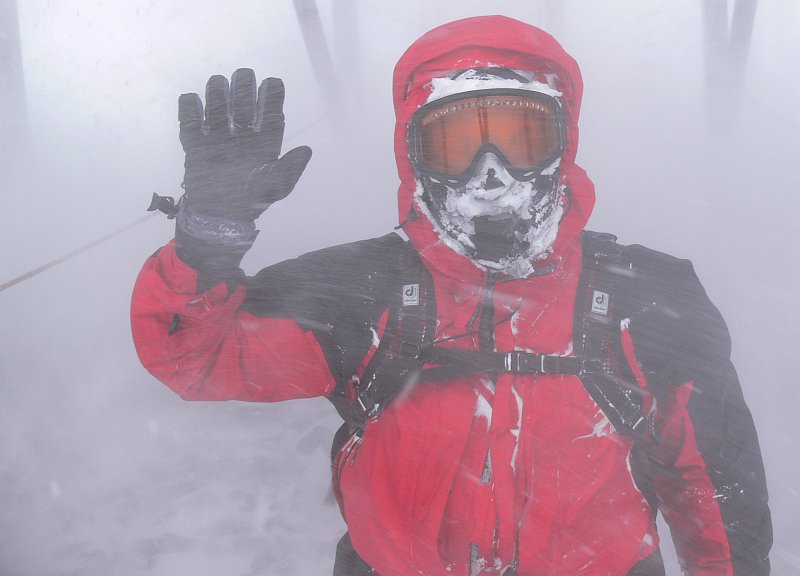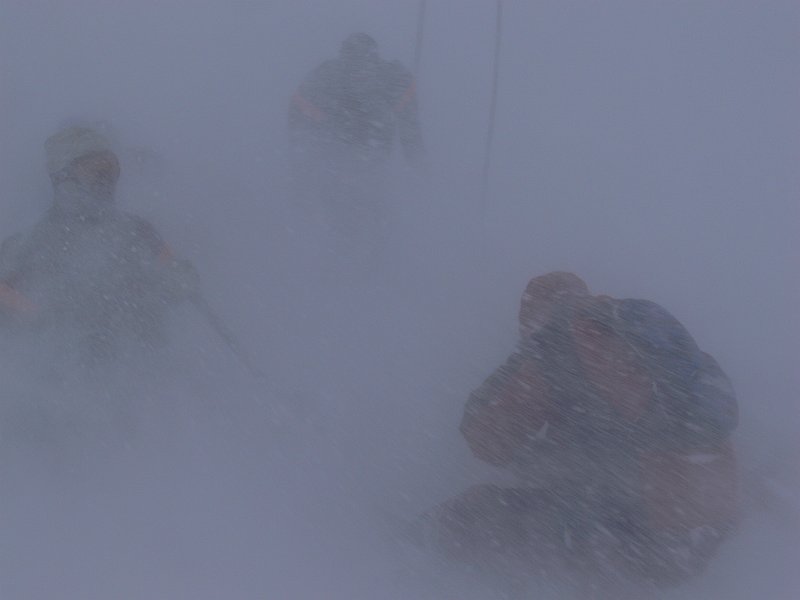March 11th, 2008

Today had special poignancy and significance – it was the last time we saw other people for the next 10 months.
The recent bad weather – despite being plenty of fun – resulted in a scheduled flight via SANAE being diverted to another base. This was unfortunate for us, as the aircraft was scheduled to bring important medical, electronic and mechanical supplies. Luckily, the company (ALCI) supporting the local Dronning Maud Land Air Network (DROMLAN) took this into account and scheduled a quick stop at SANAE to drop off the cargo.
Flight operations are always exciting here in Antarctica. On top of the pleasure of having company – however brief – there is the technical challenge of safely operating aircraft in austere conditions. The whole team is involved; we must smooth the 1200m runway with heavy machinery, plant flags, erect a wind-sock, ready fuel, man radios and provide weather information. The aircraft used for the DROMLAN flights are specially-equipped ‘Baslers’, able to operate in the cold temperatures and land on ski’s. Flown predominantly by pilots from Canada, they operate in the Antarctic during the southern summer and then fly to the high northern latitudes for the rest of the year.
Today’s stopover was one of the very last flights for the season – after visiting us at SANAE, the planes are scheduled to fly on to Neumayer, thence Halley, Rothera (on the Antarctic Peninsula) and then to Punta Arenas in South America. Due to deteriorating weather at Neumayer, we almost had the pleasure of the flight crew’s company overnight, but they were able to land with the Germans (to our disappointment). I guess it’s a tough choice between South African wine and German beer 😉
Witnessing an Antarctic take-off or landing is quite special, and spectacular. The largest cargo and groups of passengers are flown from Cape Town to Novolazarevskaya, about 500 km to our east, by the massive Russian-built Ilyushin IL-76 transport aircraft. ‘Novo’ features a large expanse of smooth blue ice which acts as a runway. From there, the Baslers fly to the bases, landing on smoothed snow and ice where available. The aircraft makes a pass over the runway, getting wind and snow conditions information from us on the ground over the radio, and then throttles back for landing. As she touches down, the snow billows and thrust is reversed to counter the inevitable slide. Once safely on the ice (a far cry from terra firma) the aircraft taxis into position at the start of the runway. Refuelling is undertaken as quickly as possible before the engines cool, while we unload cargo, serve the flight crew a hot drink, and bask in the temporary pleasure of new company. Over the course of the season, we come to know the crews, and look forward to their news in strange accents. Sometimes they bring a package from home, lovingly wrapped by the hands of family and friends – little do the crews know how much this means to us, isolated for so long. All too soon, however, they are closing the doors and powering up the turbines. Snow flies back from the aircraft, and then she springs forward, thundering down the runway and lifting off into frigid air. The horizon clears, the sound is gone, and we are alone again.
What will ten months of solitude yield?
Tags: Antarctica, dromlan, isolation, sanae
Posted in Antarctica, Base | Comments Off on Goodbye, everybody…
March 5th, 2008
 
Despite the technologically advanced and comfortable base, certain realities of life in Antarctica cannot be escaped. Antarctica may contain 67% of the world’s fresh water, but in terms of actual precipitation, it is the world’s largest desert. The water is locked away as ice, it never rains, and when snow does fall it is usually in the form of violent and windy storms. Often, the wind is so strong we are not sure if the snow is falling or simply being blown across the landscape. In order to obtain liquid water for drinking, cooking, washing, etc, we have to melt snow on a daily basis. A semi-automated system of two large tanks, with heating elements and pumps, is used for this purpose. I say semi-automated, because the most important part – filling the 4300 litre snow-melting tank with snow and ice – has to be accomplished by good old-fashioned spade-work. The ‘smelly’ must be filled about once a day to meet out average water usage. When a strong wind blows, another factor comes into play; the blowing snow gradually forms a bridge over the opening, and the smelter is covered by a snow-drift. If this is left for too long, the heat from below and pressure from above consolidates the bridge until it becomes rock-hard ice. To combat this, we must venture out and break the bridge, even when foul weather prevents us from working long enough to fill the tank with snow. Fortunately, nature takes pity on us, and often sufficient blowing snow falls in to meet our need for fresh water…if the bridge can be kept open.
For the past two days, a storm has caused the base to disappear into the swirling snow. Winds over 50 knots (90 km/h) and temperatures down to -30°C (with wind-chill) aren’t conducive to outside pursuits, but a trip to the smelter was required. Five of us suited up in multiple layers, including complete facial protection and goggles, took a safety rope, radio and GPS, and ventured out. Using a buddy system not unlike that used for scuba diving, we fought the wind down to the smelter (about 400m away from the base), dug it open, and trudged back. The blowing snow brought visibility as low as 3 meters, and goggles rapidly ice up under these conditions, making the work almost by feel. ‘Blizzard’ seems such an innocent word when compared to the sheer power of the storm – it is an effort to stay standing; the speed of the wind combined with the bitter, dry cold builds up static charge so that touching objects or other people results in jolt of electricity; the noise of the wind and bleak view leaves each person with a feeling of isolation even when warmth and safety is only a few hundred meters away.

Posted in Antarctica, Base | 2 Comments »
February 29th, 2008
The leap day brought with it one unexpected but wonderful gift – the Southern Lights. Even thought there is still a glow of sunlight on the horizon, it is now dark enough to see a few bright stars, and just before midnight the cry went up – aurora! Morgan, our resident scientist working on the space weather programme, had made the sighting. Like excited children we ran for the roof hatch in whatever clothing we could grab, charged up the ladder and tumbled onto the rooftop viewing area into the -17°C night air. Above, thin whisps of emerald green appeared against the blue-black sky for mere seconds before fading away again, almost fooling the eye into thinking they were imagined. We watched greedily as we huddled together against the icy breeze, until the last tendril was gone, and only shivering remained. Shivering, and the joy of a shared dream – witnessing the Aurora Australis.
Posted in Antarctica, Aurora Australis | 2 Comments »


